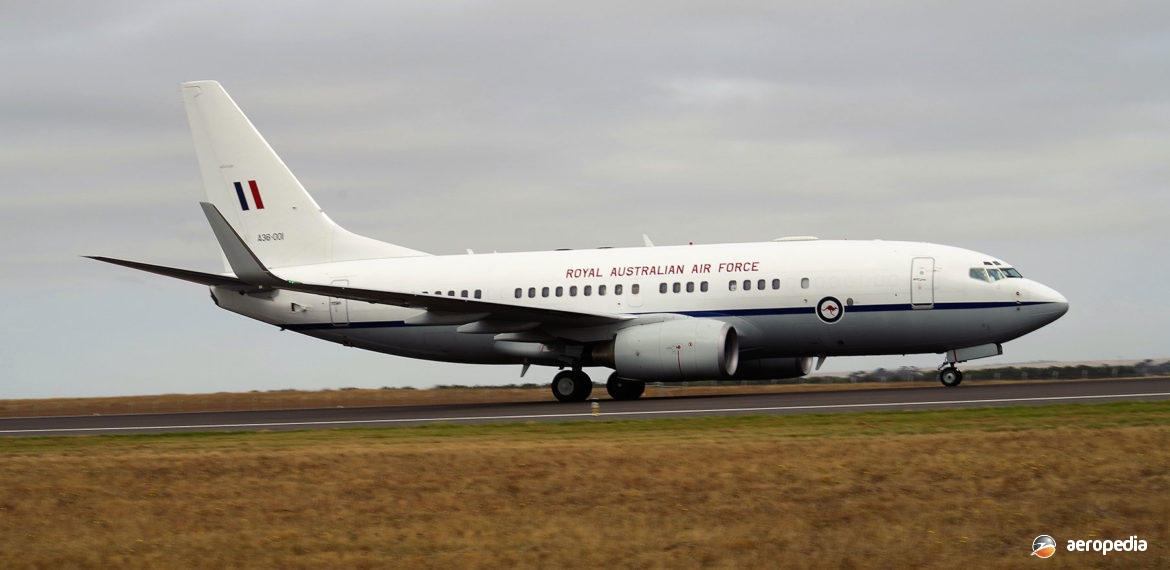Photograph:
Boeing 737-7DT (BBJ) A36-001 (c/n 30829) at Avalon, VIC in March 2017 (David C Eyre)
Country of origin:
United States of America
Description:
Long-range business and executive aircraft
Power Plant:
Two 26,400 lbst CFM International CFM56-7 turbofans
Specifications:
- Wingspan: 34.32 m (112 ft 7 in)
- Length: 33.63 m (110 ft 4 in)
- Height: 12.05 m (41 ft 2 in)
- Wing area: 125 m² (1,345.5 sq ft)
- Max cruising speed Mach: 0.82
- Normal cruising speed Mach: 0.80
- Long-range cruising speed Mach: 0.79
- Initial cruise altitude: 11,278 m (37,000 ft)
- Max certificated altitude: 12,499 m (41,000 ft)
- Range with eight passengers: 11,270 km (7,003 miles)
- Range with 25 passengers: 11,000 km (6,835 miles)
- Range with 50 passengers: 10,220 km (6,351 miles)
- Empty weight: 42,070 kg (92,740 lb)
- Loaded weight: 77,560 kg (171,000 lb)
History:
With some 5,000 examples of the Boeing 737 series delivered, and by late 2005 some further 1,000 on order, the 737 has been the most commercially successful airliner. With development continuing, it was highly likely that the company would look at providing a business-jet version. The first business jet, the BBJ-1, was based on the 737-700 series, the new model being a joint venture between Boeing and General Electric to develop and market a corporate variant of the 737.
The first BBJ was shown to the press on 11 August 1998 and made its first flight on 4 September that year. US Certification was received on 30 October. The BBJ used the airframe of the Model 737-700 and combined it with the larger and heavier fuselage centre-section, undercarriage and strengthened wing of the Model 737-800. It had the same advanced two-cockpit-crew with six LCD screen EFIS avionics, Flightdeck, dual GPS, TCAS, enhanced GPWS and Flight Dynamics heads-up guidance system. In due course it was offered with winglets built by Aviation Partners, being tested on a Model 737-800, and being offered to customers during 1999 for installation.
The Boeing Commercial Airplane Group built the basic unfurnished aircraft. The aircraft were then delivered to PATS Inc of Georgetown, Delaware where the long-range fuel tank installation took place, and it was then returned to Boeing Business Jets for interior fit-out and painting as required by the customer. Competition for the BBJ came mainly from the Airbus A319CJ business jet variant, and also from the slightly smaller Gulfstream V and the Bombardier Global Express.
The BBJ had a crew of two and the main cabin interior usually included a crew rest area, forward lounge, private suite with double bed and private bathroom facilities including a shower, 12 first class sleeper seats four-abreast, a galley at the rear, and bathroom facilities for passengers. Alternatives could be 24 passengers in two-abreast seating with a conference area and small gymnasium, or up to 63 passengers at a seating configuration of three and three.
The Business Jet has been marketed in three variants, the BBJ-1, which used the fuselage of the Model 737-700 with the strengthened wing, centre-section and undercarriage of the larger and heavier Model 737-800. Its fuel capacity was increased by the installation of nine fuel tanks in the under-floor hold, thus increasing the range to 11,485 km (7,137 miles). A variation on this model included one with three under-floor tanks, reducing range to 9,310 km (5,785 miles) but allowing up to 50 passengers to be carried with a full fuel load.
The BBJ-2 was a stretched model announced in October 1999, this being similar to the earlier model but using the longer Model 737-800 fuselage. This model had more internal room and greater baggage capacity. With maximum fuel could fly 10,623 km (6,601 miles).
The BBJ-3 was launched in October 2006 and used the fuselage of the Model 737-900ER, this model being offered with 104 m² (1,119 sq ft) of cabin space and eight under-floor fuel tanks, having a range of 10,140 km (6,301 miles). The type has been popular, with more than 100 examples delivered.
Two examples were obtained by the Australian Government for operation by the RAAF in the VIP role as A36-001 and A36-002, these being the Model 737-7DF/BBJ/W (c/ns 30790-613 and 30829-738) powered by CFM56-7B26 turbofans, delivery of the first aircrft taking place in June 2002. These aircraft have been operated by No 34 Squadron RAAF, being based, with other VIP aircraft, at Fairbairn in the ACT.
In mid-2019 it was announced the RAAF BBJ aircraft leases had been extended and they remained in service in 2020.

